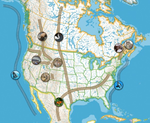 Image from SummitCountyVoice.comJust as humans need roads and highways to move between home and work, animals, especially large mammals, need protected corridors for migration, breeding, and finding food and water. These Wildlife Movement Corridors have become a vital tool for ensuring the survival of many species.
Image from SummitCountyVoice.comJust as humans need roads and highways to move between home and work, animals, especially large mammals, need protected corridors for migration, breeding, and finding food and water. These Wildlife Movement Corridors have become a vital tool for ensuring the survival of many species.
For decades, the standard approach to wildlife conservation around the world was to set aside large blocks of land that were then safeguarded from development and over-hunting. While these areas—from Yellowstone in the U.S. to the Serengeti in Africa—are vital as core habitat for thousands of species, biologists slowly realized they could not exist in isolation. In the U.S., for example, we learned that such animals as mountain lions, bighorn sheep, black and grizzly bears, elk, and many other large herbivores and carnivores regularly move between mountain ranges and other designated protected landscapes. This movement prevents inbreeding, allows escape from drought or fire-stressed environments, and lets animals follow seasonal changes in grazing or hunting. However, these corridors often cross unprotected land that is developed or in danger of being developed. By identifying where animals move, potential conflict can be mitigated or eliminated altogether.
